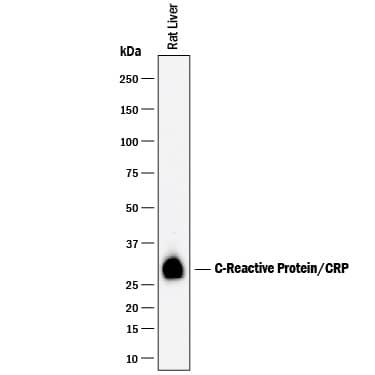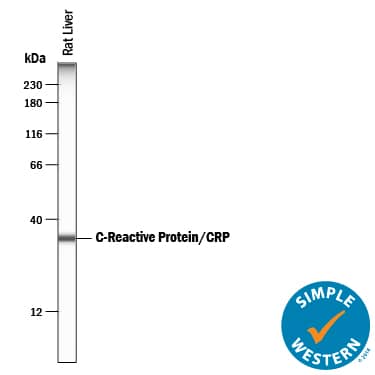Rat C-Reactive Protein/CRP Antibody
R&D Systems, part of Bio-Techne | Catalog # AF1744


Key Product Details
Species Reactivity
Validated:
Cited:
Applications
Validated:
Cited:
Label
Antibody Source
Product Specifications
Immunogen
His20-Ser230
Accession # P48199
Specificity
Clonality
Host
Isotype
Scientific Data Images for Rat C-Reactive Protein/CRP Antibody
Detection of Rat C‑Reactive Protein/CRP by Western Blot.
Western blot shows lysates of rat liver tissue. PVDF membrane was probed with 1 µg/mL of Goat Anti-Rat C-Reactive Protein/CRP Antigen Affinity-purified Polyclonal Antibody (Catalog # AF1744) followed by HRP-conjugated Anti-Goat IgG Secondary Antibody (Catalog # HAF017). A specific band was detected for C-Reactive Protein/CRP at approximately 28 kDa (as indicated). This experiment was conducted under reducing conditions and using Immunoblot Buffer Group 1.Detection of Rat C‑Reactive Protein/CRP by Simple WesternTM.
Simple Western lane view shows lysates of rat liver tissue, loaded at 0.2 mg/mL. A specific band was detected for C-Reactive Protein/CRP at approximately 34 kDa (as indicated) using 10 µg/mL of Goat Anti-Rat C-Reactive Protein/CRP Antigen Affinity-purified Polyclonal Antibody (Catalog # AF1744) followed by 1:50 dilution of HRP-conjugated Anti-Goat IgG Secondary Antibody (Catalog # HAF109). This experiment was conducted under reducing conditions and using the 12-230 kDa separation system.C-Reactive Protein/CRP in Rat Liver.
C-Reactive Protein/CRP was detected in perfusion fixed frozen sections of rat liver using Goat Anti-Rat C-Reactive Protein/CRP Antigen Affinity-purified Polyclonal Antibody (Catalog # AF1744) at 5 µg/mL overnight at 4 °C. Tissue was stained using the Anti-Goat HRP-DAB Cell & Tissue Staining Kit (brown; Catalog # CTS008) and counterstained with hematoxylin (blue). Specific labeling was localized to the cytoplasm of hepatocytes. View our protocol for Chromogenic IHC Staining of Frozen Tissue Sections.Applications for Rat C-Reactive Protein/CRP Antibody
Immunohistochemistry
Sample: Perfusion fixed frozen sections of rat liver
Simple Western
Sample: Rat liver tissue
Western Blot
Sample: Rat liver tissue
Formulation, Preparation, and Storage
Purification
Reconstitution
Formulation
Shipping
Stability & Storage
- 12 months from date of receipt, -20 to -70 °C as supplied.
- 1 month, 2 to 8 °C under sterile conditions after reconstitution.
- 6 months, -20 to -70 °C under sterile conditions after reconstitution.
Background: C-Reactive Protein/CRP
C-Reactive Protein (CRP) is a member of the pentraxin family of proteins that are characterized by a cyclic pentameric structure. The rat CRP gene encodes a 230 amino acid (aa) precursor with a signal peptide of 19 aa and the mature polypeptide of 211 aa. Rat CRP shares 64% and 70% aa sequence homology with human and mouse CRP respectively. Human, mouse and rabbit CRP are non-glycosylated proteins, and the units are non-covalently linked to form the pentameter. In contrast, rat CRP is a glycoprotein and contains a covalently linked dimer in the pentameter. CRP exhibits Ca++-dependent binding to ligands. Phosphocholine (PCh), a constituent of many bacterial and fungal walls, is a principal ligand of CRP. CRP also binds to the membrane of injured cells, the membrane and nuclear components of necrotic and apoptotic cells. Upon binding with the ligands, CRP is recognized by C1q and initiates the activation of complement cascade. Ligand bound CRP also binds to Fc gamma RI and Fc gamma RIIa on phagocytes and activates phagocytotic responses. In addition to phagocytosis, CRP also induces the production of hydrogen peroxide and inflammatory cytokines, such as IL-1, IL-6 and TNF-alpha. In human and rabbits, CRP is an important acute-phase protein that plays a role in the first line of host innate defense. The level of plasma CRP at basal conditions in human and rabbits is very low, and can increase 1,000-fold within 24‑48 hours in response to infection, inflammation or tissue damage. In rats, CRP exists at a high level at basal conditions and only increases about 2-fold in response to injury. CRP is not a typical acute-phase protein in rat and is a minor component in response to injury. In mice, CRP is expressed at very low levels and is not an acute phase reactant. Serum amyloid P component (SAP), another pentraxin, is an acute phase serum protein in mice.
References
- Mohammad, R. et al. (1992) J. Biol. Chem. 267:2947.
- Sambasivam, H. et al. (1993) J. Biol. Chem. 268:10007.
- Padilla, N.D. et al. (2003) Immunology 109:564.
- Volanakis, J.E. (2001) Molecular Immunology 38:189.
Alternate Names
Gene Symbol
UniProt
Additional C-Reactive Protein/CRP Products
Product Documents for Rat C-Reactive Protein/CRP Antibody
Product Specific Notices for Rat C-Reactive Protein/CRP Antibody
For research use only

